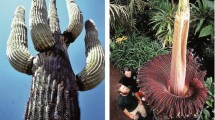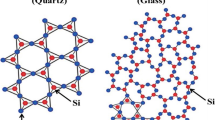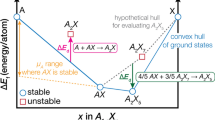Abstract
The mechanism of silicification from which the intricate cell walls of diatoms emerge, as well as the stereochemical relationship between the wall's organic casing and the siliceous materials within, continue to elude current technology. The present study further develops Hecky et al.'s standing model of the organicinorganic interface with semi-empirical computer simulations of a biosilicification pathway. Polycondensation reactions between silicic acid molecules and a hydroxyl-rich β-sheet protein template results in a stereochemically-compatible chemisorbed tetrasiloxane ring. The 24-stage reaction pathway has an activation barrier of +15.4 kcal mol-1 and results in a net stabilization of-28.0 kcal mol-1. Spatial matching and favorable thermodynamics support the theory of protein-mediated biomineralization of the diatom.
Similar content being viewed by others
References
Addadi L, Moradian J, Shay E, Maroudas NG, Weiner S (1987) A chemical model for the cooperation of sulfates and carboxylates in calcite crystal nucleation: relevance to biomineralization. Proc natn Acad Sci USA 84: 2732–2736
Aelion R, Loebel A, Eirich F (1950) Hydrolysis of ethyl silicate. J Am chem Soc 72: 5705–5712
Azam F, Hemmingsen BB, Volcani BE (1974) Role of silicon in diatom metabolism. V. silicic acid transport and metabolism in the heterotrophic diatom Nitzschia alba. Archs Microbiol 97: 103–114
Blakey PR, Earland C, Stell JGP (1963) Calcification of keratin. Nature, Lond 198: p. 481
Burggraf LW, Davis LP, Gordon MS (1992) Neutral and anionic hypervalent silica complexes in silanol polymerization. In: Uhlmann DR, Ulrich DR (eds) Ultrastructure processing of advanced materials. Wiley, New York, pp 47–55
Carlisle EM (1974) Silicon as an essential element. Fedn Proc Fedn Am Socs exp Biol 33: 1758–1766
Crenshaw MA (1991) Mineral induction by immobilized polyanions. In: Suge S, Nakahara H (eds) Mechanisms and phylogeny of mineralization in biological systems. Springer-Verlag, Tokyo, pp 101–105
Dewar MJS, Jie C (1987) Organometallics. J Am Chem Soc 6: 1486–1490
Dewar MJS, Zoebisch EG, Healy EF, Stewart JP (1985) AM1: a new general purpose quantum mechanical molecular model. J Am chem Soc 107: 3902–3909
Fraser RDB, MacRae TP (1973) Conformation in fibrous proteins and related synthetic polypeptides. Academic Press, New York
Hartwig BA, Hench LL (1972) Epitaxy of poly-1-alanine on α-quartz and glass-ceramic surfaces. J biomed Mater Res 6: 413–423
Hecky RE, Mopper K, Kilham P, Degens ET (1973) The amino acid and sugar composition of diatom cell-walls. Mar Biol 19: 323–331
Hench LL (1992) The kinetics of bioactive ceramics. Part I. Reaction rates. In: Hulbert JE, Hulbert SF (eds) Bioceramics. Vol. 3. Rose-Hulman Institute of Technology, Terre Haute, pp 43–45
Hench LL (1994) Biochemical processing of materials: a review. In: Cheetham AK, Brinker CJ, Mecartney ML, Sanchez C (eds) Better ceramics through chemistry. VI. Materials Research Society, Pittsburgh, pp 993–1004
Hench LL, West JK (1990) The sol-gel process. Chem Rev 90: 33–72
Hildebrand M, Higgins DR, Busser K, Volcani BE (1993) Siliconresponsive cDNA clones isolated from the marine diatom Cylindrotheca fusiformis. Gene 132: 213–218
Iler RK (1979) The chemistry of silica. Wiley, New York
Keefer KD (1984) The effect of hydrolysis conditions on the structure and growth of silicate polymers. In: Brinker CJ, Clark DE, Ulrich DR (eds) Better ceramics through chemistry. North-Holland, New York, pp 15–24
Kelts LW, Armstrong NJ (1989) A silicon-29 NMR study of the structural intermediates in low pH sol-gel reactions. J Mater Res 4: 423–433
Li C-W, Volcani BE (1984) Aspects of silicification in wall morphogenesis of diatoms. Phil Trans R Soc (Ser B) 304: 519–528
Lowenstam HA, Weiner S (1989) On biomineralization. Oxford University Press, New York
Mann S, Archibald DD, Didymus JM, Douglas T, Heywood BR, Meldrum FC, Reeves NJ (1993) Crystallization at inorganic-organic interfaces: biominerals and biomimetic synthesis. Science, NY 261: 1286–1292
Mark HF (1985) Biopolymers. In: Graber E, Klingsberg A, Siegel PM (eds) Concise encyclopedia of chemical technology. Wiley, New York, pp 168–170
Mathews CK, van Holde KE (1990) Biochemistry. Benjamin/Cummings, New York
Pautard FGE (1963) Mineralization of keratin and its comparison with the enamel matrix. Nature, Lond 199: 531–535
Perry CC (1989) Chemical studies of biogenic silica. In: Williams RJP (ed) Biomineralization: chemical and biochemical perspectives. Weinheim, New York, pp 223–256
Perry CC, Fraser MA, Hughes NP (1991) Macromolecular assemblages in controlled biomineralization. In: Sikes S, Wheeler AP (eds) Surface reactive peptides and polymers. American Chemical Society, Washington, DC, pp 316–339
Samata T (1991) Structure and function of the organic matrix in the nacreous layer of Pinctada fucata. In: Suga S, Nakahara H (eds) Mechanisms and phylogeny of mineralization in biological systems. Springer-Verlag, Tokyo, pp 23–27
Schwarz K (1974) Recent dietary trace element research, exemplified by tin, fluorine, and silicon. Fedn Proc Fedn Am Socs exp Biol 33: 1748–1757
Simkiss K (1991) Amorphous minerals and theories of biomineralization. In: Suga S, Nakahara H (eds) Mechanisms and phylogeny of mineralization in biological systems. Springer-Verlag, Tokyo, pp 375–382
Stetler-Stevenson WG, Veis A (1986) Type I collagen shows a specific binding affinity for bovine dentin phosphophoryn. Calcif Tissue int 38: 135–141
Sullivan CW (1986) Silicification by diatoms. In: Evered D, O'Connor M (eds) Silicon biochemistry. Wiley, New York, pp 59–86
Sullivan CW, Volcani BE (1981) Silicon in the cellular metabolism of diatoms. In: Simpson TL, Volcani BE (eds) Silicon and siliceous structures in biological systems. Springer-Verlag, New York, pp 15–42
Swift BM, Wheeler AP (1992) Evidence of an organic matrix from diatom biosilica. J Phycol 28: 202–209
Volcani BE (1981) Cell wall formation in diatoms. In: Simpson TL, Volcani BE (eds) Silicon and siliceous structures in biological systems. Springer-Verlag, New York, pp 157–200
Wallace S, West JK, Hench LL (1993) Interactions of water with trisiloxane rings. Part I. Experimental analysis. J non-crystalline Solids 152: 101–108
Weiss A, Herzog A (1978) Isolation and characterization of a silicon-organic complex from plants. In: Bendz G, Lindqvist I (eds) Biochemistry of silicon and related problems. Plenum Press, New York, pp 109–127
West JK, Hench LL (1994) AM-1 molecular orbital calculations of silica-alanine-nitrogen interactions. J biomed Mater Res 29: 625–633
West JK, Hench LL (1995) Molecular orbital models of silica. In: BW Wessels, Kaufmann EN, Giordmaine JA, Wachtman JB (eds) Annual review of materials. Annual Reviews Inc., Palo Alto, pp 37–68
West JK, Wallace S (1990) Molecular orbital modeling of water adsorption on a tetrasiloxane ring. In: Zelinski BJJ, Brinker CJ, Clark DE, Ulrich DR (eds) Better ceramics through chemistry. IV. Materials Research Society, Pittsburgh, pp 255–260
West JK, Wallace S (1992) Raman spectroscopy and quantum molecular orbital studies of the stability of trisiloxane silicate rings with respect to water. In: Hench LL, West JK (eds) Chemical processing of advanced materials. Wiley, New York, pp 159–171
West JK, Wallace S (1993) Interactions of water with trisiloxane rings. II. Theoretical analysis. J non-crystalline Solids 152: 109–117
Williams RJP (1984) An introduction to biominerals and the role of organic molecules in their formation. Phil Trans R Soc (Ser B) 304: 411–424
Zerner MC (1991) Semi-empirical molecular orbital methods. In: Lipkowitz KB, Boyd DB (eds) Reviews in computational chemistry. II. VCH Publishers, New York, pp 313–365
Author information
Authors and Affiliations
Additional information
Communicated by N. H. Marcus, Tallahassee
Rights and permissions
About this article
Cite this article
Lobel, K.D., West, J.K. & Hench, L.L. Computational model for protein-mediated biomineralization of the diatom frustule. Marine Biology 126, 353–360 (1996). https://doi.org/10.1007/BF00354617
Received:
Accepted:
Issue Date:
DOI: https://doi.org/10.1007/BF00354617




